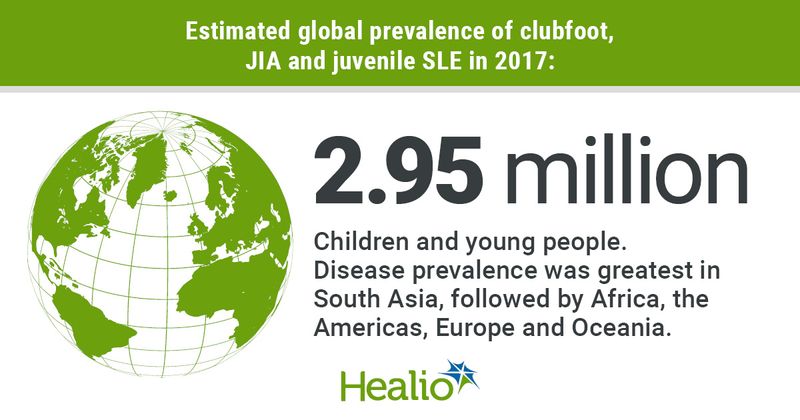Nearly 3 million children worldwide live with clubfoot, JIA or juvenile lupus
An estimated 2.95 million children and young people worldwide live with clubfoot, juvenile idiopathic arthritis or juvenile systemic lupus erythematosus, with the greatest prevalence in South Asia, researchers reported.
“There is a lack of global comparable data on the burden of musculoskeletal conditions in children and young people,” Helen E. Foster, MD, MBBS, FRCP, FRCPCH, of Newcastle University in Malaysia, told Healio Rheumatology. “This study has estimated the global prevalence of three chronic musculoskeletal conditions; with talipes equinovarus, or clubfoot, in children under 5 years of age and with juvenile idiopathic arthritis or juvenile SLE in the under 16-year-olds. The estimates were based on World Bank population data and known prevalence for each condition and data presented for each U.N. region and subregion.”

To estimate the global prevalence of these musculoskeletal conditions, Foster and colleagues analyzed 2017 population information from the World Bank Group DataBank, covering 217 countries, and their findings were published in Pediatric Rheumatology. Data were stratified by age in single years, from 0 to 15years, for men and women separately. Meanwhile, the researchers accessed information on geographic regions and subregions for the classification of countries from the United Nations Statistics Division.
The researchers estimated 2017 prevalence figures using the reported prevalence rates of 1 per 1,000 for clubfoot, 1 per 1,000 for juvenile idiopathic arthritis (JIA) and 10 per 100,000 for juvenile SLE, as well as the 2017 population of children younger than 5 years for clubfoot and those younger than 16 years for JIA and juvenile SLE based on country, region and subregion. To accomplish this, they used the following equation: estimated prevalence of musculoskeletal condition equals reported prevalence rate X population.

According to the researchers, there were approximately 675,061 children younger than 5 years with clubfoot among a pool of 675,100,000 in that age range. In addition, there were approximately 2,069,246 adolescents younger than 16 years with JIA, and approximately 206,931individuals younger than 16 years with juvenile SLE, per 2,069,000,000 people in that age range. In all, about 2,951,238 were living with one of the three conditions in 2017. Disease prevalence was greatest in South Asia, followed by Africa, the Americas, Europe and Oceania.
“The data suggests approximately 3 million children and young people globally are currently living with one of these conditions and over 2 million with JIA,” Foster said. “Most affected children are living in Asia and Africa and often in low-resource settings. The tragedy is that these conditions are treatable, and disability can be prevented.
“Many of the affected children are living in countries with little or low access to specialist care and without treatment, there is huge lifelong impact with social exclusion and poverty,” she said. “Further work is needed urgently to engage with global stakeholders to work together to improve access to effective care for the many who are affected and reduce the otherwise adverse lifelong impact on their health, quality of life and the impact on society.”
